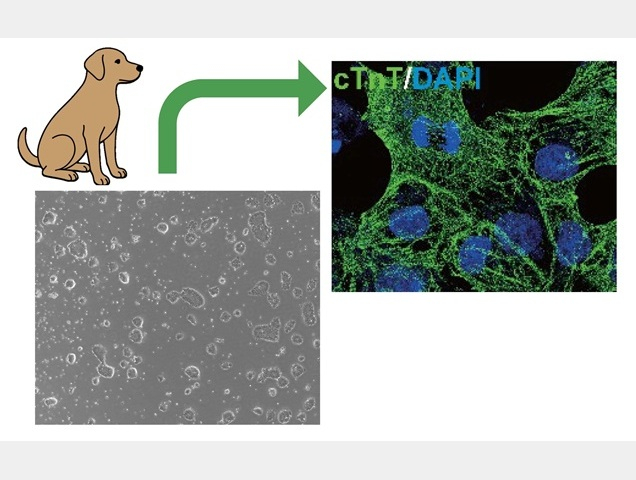Research News
Nov 21, 2025
- Veterinary Science
New stem cell medium creates contracting canine heart muscle cells
Researchers have created a special culture medium that allows dog stem cells to stably differentiate into functional heart muscle cells complete with contractions
Canine iPS cells cultured in a newly developed medium successfully differentiated into functional cardiomyocytes
Scientists obtained stem cells expressing cardiac muscle-specific genes and proteins. The cells displayed regular rhythmic contractions similar to a heart, confirming that they were functional cardiomyocyte cells.
Credit: Osaka Metropolitan University

In research, induced pluripotent stem (iPS) cells are derived from skin, urine, or blood samples and developed into other cells, like heart tissue, that researchers want to study. Because of the similarities between certain dog and human diseases, canine iPS cells have potential uses in regenerative medicine and drug discovery.
Research on iPS cells is challenging because the cells are extremely sensitive to culture conditions. Before they are developed into other cells, iPS cells are in an undifferentiated state. At this stage, the cells are grown in a culture medium that provides the essential nutrients, growth factors, and signaling molecules that they require. However, optimizing these components is tricky, leading many cells to fail to maintain their pluripotency (ability to become any cell type) or differentiate in undesirable ways. As a result, the medium often constrains what researchers can achieve.
An international team led by Professor Shingo Hatoya of the Graduate School of Veterinary Science at Osaka Metropolitan University has developed a new culture medium, ‘AR medium,’ that transforms canine iPS cells into cardiomyocyte cells—the muscle cells that contract the heart.
Using AR medium, the researchers created the specific conditions required for proliferation in their undifferentiated state. They then established culture conditions suitable for the undifferentiated iPS cells to undergo differentiation into cardiac tissue. The result was cells that expressed genes and proteins that are only found in heart muscle cells.
The researchers also observed rhythmic contractions similar to a beating heart; the gold standard of whether the cells are functionally heart cells.
Far from simply being similar to heart muscle cells, these cells were functionally identical to cardiomyocytes. This would allow them to be used to test how new compounds affect heart rhythm, contractility, and safety before clinical trials and evaluate drug efficacy and safety.
“Our research contributes to the development of treatments and could play an important role in preclinical studies for genetic abnormalities common to both humans and dogs that involve similar genetic pathways, such as dilated cardiomyopathy,” Hatoya said. “Research using canine stem cells is expected to accelerate the development of regenerative medicine and genetic disease treatments for humans.”
The AR medium also potentially allows researchers to differentiate the iPS cells into cell types other than cardiomyocytes. Professor Hatoya is excited about the possibilities: “Using the medium would expand the potential use of iPS cells in regenerative medicine and allow researchers to investigate molecules to treat difficult-to-treat diseases including everything from heart and liver disease to neurological disorders.”
The study was published in Stem Cell Reports.
Funding
This work was supported by grants from JSPS KAKENHI (grant numbers 21H02378 and 24K21916) and a grant from the Center for Companion Animal Health at UC Davis (grant number 2023-60-F).
Paper information
Journal: Stem Cell Reports
Title: Signaling pathway-based culture condition improves differentiation potential of canine induced pluripotent stem cells
DOI: 10.1016/j.stemcr.2025.102640
Authors: Toshiya Nishimura, Kazuto Kimura, Kyomi J. Igarashi, Kohei Shishida, Hiroko Sugisaki, Masaya Tsukamoto, Aadhavan Balakumar, Chihiro Funamoto, Masumi Hirabayashi, Amir Kol, Shingo Hatoya
Published: 18 September 2025
URL: https://doi.org/10.1016/j.stemcr.2025.102640
Contact
Shingo Hatoya
Graduate School of Veterinary Science
Email: hatoya[at]omu.ac.jp
*Please change [at] to @.
SDGs

